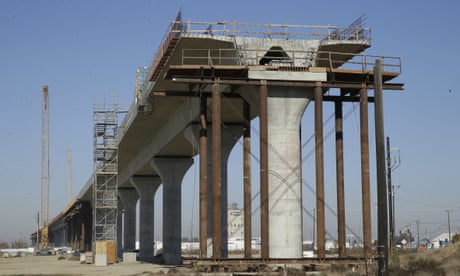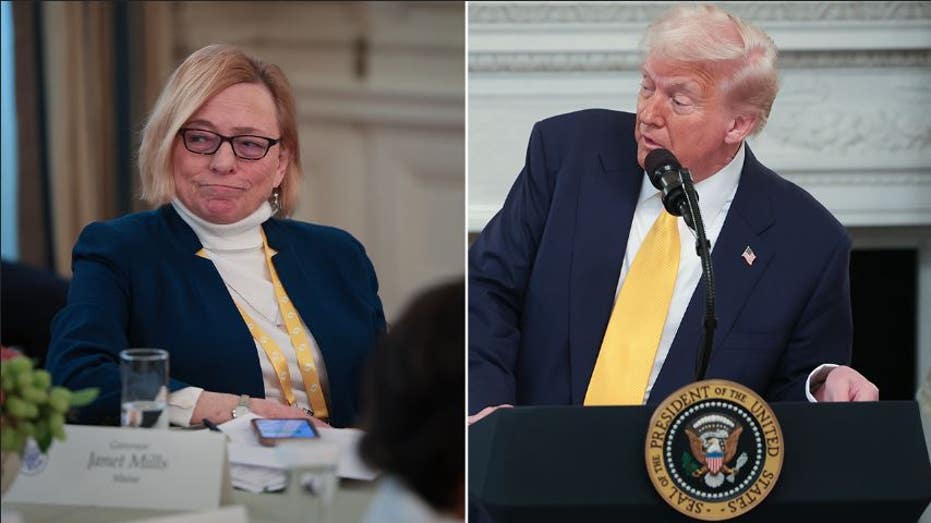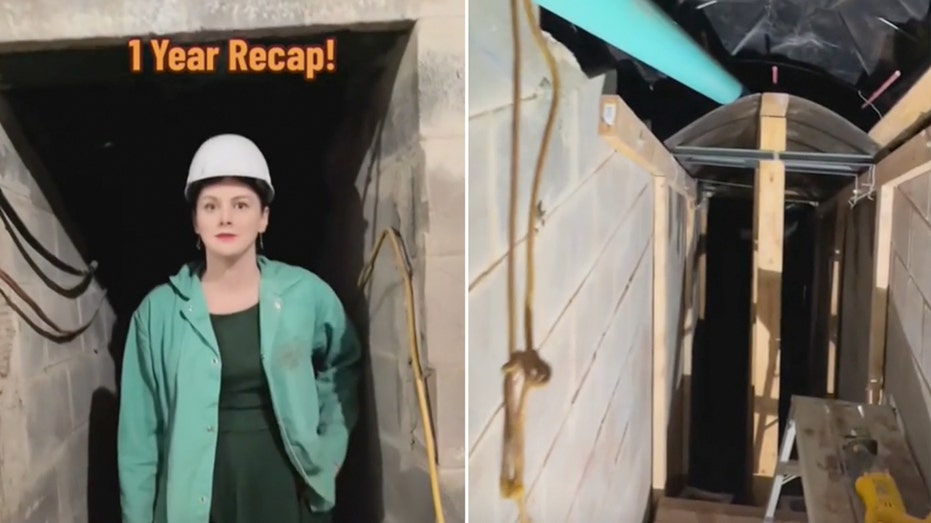- by foxnews
- 15 Mar 2025
Train to nowhere: can California’s high-speed rail project ever get back on track?
Train to nowhere: can California’s high-speed rail project ever get back on track?
- by theguardian
- 30 May 2022
- in news

In the depths of the 2008 recession, Californians were sold on a beautiful dream: a bullet train that would whisk them between Los Angeles and San Francisco in less than three hours.
The project was to be the start of a new era of high-speed rail that would eventually stretch the full length of the west coast, from San Diego to Vancouver, across the desert to Las Vegas, and, eventually, all across the continental United States.
California voters that year approved the sale of $9bn in state bonds, on the understanding that the LA to San Francisco line would be up and running by 2020. It was not long before the incoming Obama administration upped the ante, with a national plan for 8,600 miles (13,840 km) of high-speed rail lines, later increased to 12,000 miles (19,312 km), that would help kick-start a dormant economy and wean a highly mobile nation off the fossil fuels threatening to destroy the climate.
Fast-forward to the present, and the dream is all but dead. The Obama plan collapsed, falling victim to a combination of inexperience, mismanagement and furious opposition from several key Republican legislators and state governors. The California project is still technically up and running, but it is so far behind schedule that it has yet to lay a single mile of track, despite 14 years of work and about $5bn spent.
California's governor, Gavin Newsom, is no longer talking about the 500-mile stretch from LA to San Francisco, because the projected price tag has skyrocketed far out of reach. Instead, his office is focusing on a 172-mile segment connecting a handful of medium-sized cities in the flat agricultural Central Valley. Even if the stars align, though, and a restive legislature can be persuaded to release the necessary funds, the segment still might not start serving passengers until 2030.
The optimistic view for the project's future - espoused most vigorously by California's high speed rail authority, its consultants and its lobbyists - is that the stretch from Merced to Bakersfield will, once finished, provide proof of concept and thus convince state and federal authorities to shell out the many tens of billions of extra dollars it would take to extend the line north and south. Yes, the project is expensive, they argue, but so were the public investments in the highway system and the passenger airline industry, and the economic benefits of those are inarguable.
The boosters also sense a unique opportunity, since California is currently running a $97.5bn budget surplus and the White House, led by "Amtrak Joe" Biden, has been offering billions more, largely thanks to last year's Infrastructure Investment and Jobs Act which allocated up to $108bn for public transport projects. "All we need is one system up and running. The rest will follow," the editor of the industry publication Railway Age, William C Vantuono, all but pleaded in a recent article. "California right now is our only hope," he added.
The more pessimistic view is that the project has turned into a boondoggle, the proverbial "train to nowhere", and no good can come of continuing to throw money at it. The Merced to Bakersfield stretch is projected to cost more than $20bn - several billion dollars more than a previous projection made in 2019 and likely to grow only more expensive. It is also far from clear who would ride on it since it largely duplicates an existing Amtrak rail route.
"It's dreamland. It's unrealistic. It will never cover its own expenses from the farebox," said Quentin Kopp, a retired former legislator and judge who led the charge for an LA-San Francisco high speed line for two decades, starting in the 1990s, but has now lost hope that it will ever see the light of day.
The high speed rail authority said it was "simply untrue" to suggest that its timeline and budget projections were unrealistic. Authority spokeswoman Annie Parker stopped short of predicting that the Merced-Bakersfield leg would break even, however, saying only: "We see a robust demand and a profitable system in our future."
Newsom is making his second attempt in two years to jump-start construction by persuading the legislature to release the remaining $4.2bn left in the 2008 bond fund and combine it with federal money to jump-start construction. "This is the future of transportation in California," he said in a promotional video released when he first launched his funding campaign in March 2021. When completed, he promised, the high-speed line through the Central Valley would take 400,000 cars off the roads, clean up the air, and create new jobs.
Even if Newsom gets his money, though, it is far from clear what it will buy. The state's legislative analyst complained earlier this year about a lack of up-to-date budgetary information, making it "very difficult for the legislature to make informed decisions".
The legislature, for its part, has shown a particular reluctance to electrify the line from Merced to Bakersfield up front, and if that decision sticks it would reduce the line, at least temporarily, to a conventional track unable to meet the promise of 220-mph speeds. The rail authority, meanwhile, has developed its own plan to start with just 119 out of the 172 miles - a plan that among other things, would leave riders 19 miles short of Bakersfield and oblige them to complete the journey by bus. Authority chief executive Brian Kelly acknowledged in the most recent business plan that this is "not an ideal operating segment".
As legislative leaders haggle with Newsom over high-speed rail and the rest of California's latest budget, they are not tipping their hands about possible outcomes. But a number of them went into the talks skeptical if not downright hostile. "The idea that you would spend all your money on a train that doesn't connect to anything and just hope you're going to get more money, I find a really frightening business proposition," the chair of the California Assembly's transportation committee, Laura Friedman, told the policy news site Cal Matters earlier this month.
Many of the skeptics, including Friedman, are big-city Democrats, legislators one would usually expect to embrace public investment in high-speed rail. So their skepticism - and the failures, delays, cost overruns and broken promises that lie behind it - is a particularly heavy blow to those Americans who love the idea of reviving rail travel in a country that was largely built on it.
These are people who have ridden the Eurostar, or darted through the Tuscan countryside en route from Rome to Milan, and want nothing more than to see similar systems in place at home. "When people experience this in the United States," industry consultant and unabashed train lover Eric C Peterson said, "they're going to say: why couldn't we have had this earlier?"
High-speed rail in California was always going to be a moon shot. Many transportation experts point out that high-speed rail systems are tricky to deliver because of high start-up costs and long construction schedules, and the costs are often compounded by the complications of purchasing land, building stations, blasting through mountains and bridging rivers. Countries that have moved fastest on such systems tend to have a highly centralized governmental system, like France's, if not an out-and-out authoritarian one, like China's.
The United States, by contrast, has a highly decentralized system of government, with multiple competing jurisdictions jostling over land, water, electricity and other vital resources, and a political tradition, especially in the west, that celebrates personal freedom and private property over collective enterprises in the public interest.
In the decades after the second world war, inter-city train travel faded fast because of the boom in car ownership, cheap gasoline and the interstate highway system. Today, it has a meaningful presence only on the northeastern seaboard, where Amtrak trains remain a popular, traffic-beating option between Boston, New York and Washington. In most places, Tom Zoellner writes in his 2014 book Train, the American railroad "is still regarded as a charming antique, an object of art for eccentrics and a last resort for the poor. Approximately 98% of the American public has never set foot on a city-to-city train."
While European countries have developed high-speed systems with a lot of accumulated expertise and a pre-existing base of regular riders, the US flew almost completely blind in the years after 2008. California's leaders didn't want to finance a high-speed rail line without voter approval, and when Quentin Kopp chaired the effort to craft a successful ballot initiative he found himself boxed in by requirements deemed politically necessary that arguably doomed the project from the outset.
The initiative promised a journey time between LA and San Francisco of two hours and forty minutes - a timeframe that demanded exceptionally high speeds if the train was to stop anywhere along the way and greatly complicated the engineering. The initiative also promised that the service would pay for itself, with no operating subsidy, a promise that now seems near-impossible to keep.
After voters approved Proposition 1A, narrowly, the High-Speed Rail Authority found itself woefully understaffed and spent a small fortune on outside consultants, who wrote lots of reports and hired lots of other consultants but did not get the line built. Even today, progress consists of just a handful of new viaducts and bridges, along with most (but not all) of the necessary land purchases and environmental approvals.
That's still better than the rest of the country, where every last high-speed rail project proposed during the Obama era has been dropped, in large part because of furious resistance from Republican governors and legislators. By now, Republican party orthodoxy is hotly opposed to high-speed rail, in line with a 2021 Cato Institute study that called it "an obsolete technology because it requires expensive and dedicated infrastructure that will serve no purpose other than moving passengers who could more economically travel by highway or air".
When Newsom first announced he was paring back the California project, in 2019, it prompted the Trump administration to yank back nearly $1bn in federal funding. While the money has since been restored by the Biden administration, many California legislators worry that if the Republicans take back Congress after this November's mid-term elections or - worse - if they take back the White House in 2024, it could kill whatever is left of the country's last surviving high-speed rail project, regardless of what gets decided in Sacramento.
A growing number of critics thinks California may have made a strategic mistake with its"high-speed rail or bust" approach and should have put more money into lower-cost projects to link the disparate parts of the existing state rail network. Kopp, still formidable and furious at the age of 93, agrees with that approach. He thinks the only responsible thing to do at this point is declare high-speed rail a failure and devote the remaining money in the bond fund to extension projects in the Los Angeles and San Francisco metropolitan areas.
"I think it's done," he said. "Nobody else in the United States is wasting money on this. The legislature should stop the funding again this year, and Newsom should wise up before it becomes part of the historical record that he threw our money away."
- by foxnews
- descember 09, 2016
Neighbors react as viral 'Tunnel Girl' granted permit to continue digging massive bunker under home
"Tunnel Girl" in Herndon, Virginia, "finally" got her tunnel project approved after pausing the project due to a potential violation. Locals and social media users react.
read more


